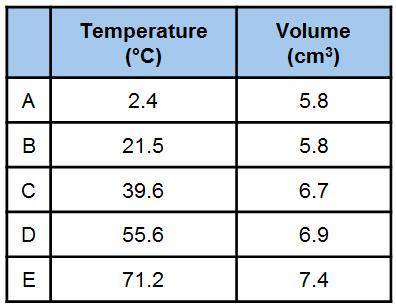
Chemistry, 21.04.2020 23:44, simplydimps22owbohb
A 3-column table with 5 rows. Column 1 is unlabeled with entries A, B, C, D, E. Column 2 is labeled Temperature in degrees Celsius with entries 2.4, 21.5, 39.6, 55.6, 71.2. Column 3 is labeled Volume in cubic centimetres with entries 5.8, 5.8, 6.7, 6.9, 7.4.
A student collected the data shown above. Row may represent an error.
What might the student have done that caused this error? List all possible causes.


Answers: 2
Other questions on the subject: Chemistry

Chemistry, 22.06.2019 05:00, foreignking02
1)each group 16 element has how many valence electrons? ( )4 ( )6 ( )8 ( )16 2)how many dots appear in the dot structure for calcium ion, ca2+? ( )zero ( )one ( )two ( )eight 3) which of the following atoms forms a cation to obtain an octet of outer shell electrons? ( )magnesium ( )oxygen ( )fluorine ( )helium 4) an al3+ ion contains 13 protons and 10 electrons. ( )true ( )false 5) valence and non-valence electrons are represented in lewis dot structures. ( )true ( )false
Answers: 3

Chemistry, 22.06.2019 12:30, UaRemomGAY
If anyone would be able to me out with these three questions it would be these are from the chem 2202 course.
Answers: 3

Chemistry, 22.06.2019 13:30, Sbeech7246
Why does asexual reproduction result in offspring with identicle genetic variation
Answers: 2

Chemistry, 22.06.2019 14:30, jessiereyes2924
What is the relationship between wind and ocean waves? question 17 options: wind moving at higher speeds will transfer more energy to the water, resulting in stronger waves. wind moving at higher speeds will transfer energy over a larger part of the ocean water, resulting in waves with a shorter wavelength. winds moving at higher speeds with cause water to move forward at faster rates, causing larger ocean waves. winds moving at higher speeds will affect deeper water, resulting in waves that move at a faster rate. how do temperature and salinity affect deepwater currents? question 15 options: as temperatures and salinity levels of water increase, the water rises to the surface where it creates currents as it moves to colder regions. they create changes in wind direction, moving denser water in the same direction as the wind and causing the deepwater circulation patterns found in the ocean. they equalize the forces on undersea currents caused by the coriolis effect as they replace more dense water with less dense water. they create density differences that cause dense deepwater currents to flow toward the equator where they displace less dense, warmer water above them.
Answers: 2
Do you know the correct answer?
A 3-column table with 5 rows. Column 1 is unlabeled with entries A, B, C, D, E. Column 2 is labeled...
Questions in other subjects:


Computers and Technology, 20.05.2021 20:20

English, 20.05.2021 20:20

History, 20.05.2021 20:20

English, 20.05.2021 20:20


English, 20.05.2021 20:20

History, 20.05.2021 20:20

History, 20.05.2021 20:20






